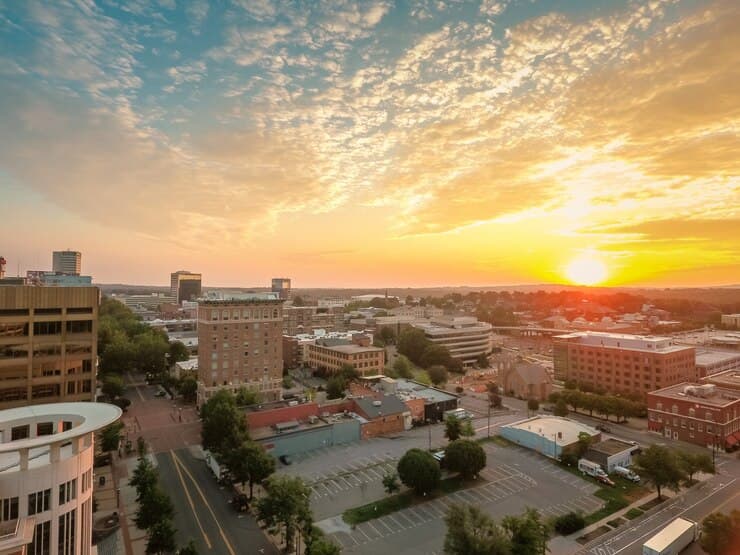
South Carolina, nestled in the southeastern United States, boasts a tapestry of cities that collectively define its cultural, economic, and social identity. In this comprehensive exploration, we delve into the dynamic landscape of the Palmetto State, focusing on its ten largest cities by population.
Beyond mere statistics, we will uncover the unique stories, economic intricacies, and cultural vibrancy that make each city a distinctive contributor to the rich mosaic of South Carolina.
Columbia: The Capital Marvel of South Carolina
Columbia, with a population exceeding 130,000 residents, stands proudly as the capital of South Carolina.

This vibrant city is a melting pot of cultures, with a demographic tapestry that reflects a harmonious blend of age groups, ethnicities, and backgrounds.
The economic pulse of Columbia beats strongly, driven by key sectors such as healthcare, education, and government. Home to the prestigious University of South Carolina, the city enjoys the intellectual and economic vibrancy brought about by a robust education sector. Government institutions further contribute to the economic stability of the region.
Columbia is not just a political and economic hub; it is a cultural epicenter. Festivals like the “Soda City Suds Week” and the “World Beer Festival” showcase the city’s commitment to celebrating diversity and fostering a sense of community.
Residents and visitors alike find themselves immersed in a myriad of events, establishing Columbia as a cultural beacon in South Carolina.
Charleston: Where History Meets Modernity
- Population Nuances: Charleston’s population of over 140,000 is a dynamic mix of locals and newcomers, drawn to the city’s historical charm and modern amenities;
- Economic Landscape: The economic growth in Charleston is multifaceted, spanning tourism, technology, and manufacturing. The city’s historic district and plantations contribute to its unique economic landscape;
- Educational Highlights: Charleston’s educational institutions, including the College of Charleston, add an intellectual dimension to the city. The intersection of history and education enhances the overall appeal of Charleston.
North Charleston: A Thriving Metropolis
- Population Dynamics: With a population exceeding 120,000, North Charleston reflects a diverse and dynamic urban environment;
- Economic Thrive: North Charleston’s strategic location and industrial developments drive economic thrive. Boeing’s presence has further solidified the city’s position as an industrial and economic hub;
- Cultural Diversity: The city’s cultural diversity is celebrated through events like the North Charleston Arts Fest, fostering a sense of community and pride.
Explore more South Carolina cities by population in this review
Mount Pleasant: Coastal Charm and Growth

Mount Pleasant’s population has witnessed a steady increase, reaching over 90,000. The city’s coastal charm and strategic location contribute to its allure.
- Economic Opportunities: The tourism industry, coupled with healthcare and retail, fuels Mount Pleasant’s economic opportunities. The city’s commitment to sustainable growth ensures a balance between development and preservation;
- Quality of Life: Residents enjoy a high quality of life, with access to scenic waterfronts, parks, and cultural attractions, making Mount Pleasant a desirable place to live.
Rock Hill: The Economic Powerhouse
- Population Dynamics: Rock Hill’s population exceeds 75,000, reflecting a mix of families, young professionals, and students from Winthrop University;
- Economic Landscape: Rock Hill is recognized as an economic powerhouse, driven by sectors like manufacturing, healthcare, and information technology. The city’s commitment to fostering innovation positions it as a leader in economic development;
- Educational Opportunities: The presence of Winthrop University and York Technical College enhances educational opportunities, attracting students and contributing to the city’s intellectual vibrancy.
Greenville: A Cultural Hub in the Upstate
Greenville, nestled in the Upstate region, boasts a population surpassing 70,000, characterized by its diversity. The city attracts residents with its vibrant cultural scene, creating a melting pot of artistic expressions and traditions.
- Economic Vibrancy: Greenville’s economic landscape is marked by growth in manufacturing, technology, and healthcare. The city has successfully transitioned from its industrial past to become a hub for innovation and sustainable development. This economic vibrancy attracts businesses and professionals, contributing to Greenville’s position as a key player in South Carolina’s economic landscape;
- Cultural Offerings: The cultural offerings in Greenville add a distinctive charm to the city. Events such as Artisphere and the Upstate Shakespeare Festival showcase the city’s commitment to the arts.
The Peace Center for the Performing Arts stands as a cultural beacon, hosting a wide array of performances and events that enrich the lives of residents and visitors alike.
Summerville: Small-Town Feel with Big Opportunities
- Population Growth: Despite its small-town feel, Summerville’s population has surged past 55,000, reflecting the city’s appeal and growth;
- Economic Prospects: Summerville’s economic prospects are on the rise, with a focus on industries like healthcare, manufacturing, and technology. The Nexton development project exemplifies the city’s commitment to sustainable growth;
- Educational Institutions: Summerville’s proximity to Charleston provides residents with access to educational institutions, enhancing the city’s educational landscape.
Goose Creek: Community and Commerce
Goose Creek’s population, exceeding 45,000, mirrors its emphasis on community and commerce.

- Economic Development: The city’s economic development initiatives, including the Crowfield Golf and Country Club, contribute to a thriving business environment. The presence of the Naval Weapons Station Charleston further bolsters economic activities;
- Community Engagement: Goose Creek’s commitment to community engagement is evident through events like the Fall Festival and community outreach programs, fostering a sense of belonging among residents.
Hilton Head Island: Coastal Gem with Economic Brilliance
- Population Highlights: Hilton Head Island’s population, surpassing 40,000, is characterized by a mix of permanent residents and seasonal visitors;
- Economic Impact: The tourism industry plays a pivotal role in Hilton Head Island’s economic landscape. The city’s commitment to environmental sustainability aligns with its reputation as a premier coastal destination;
- Recreational Opportunities: Residents and visitors enjoy a plethora of recreational opportunities, including golf, water sports, and nature exploration, making Hilton Head Island a haven for those seeking a coastal lifestyle.
Spartanburg: The City of Innovation
Spartanburg, with a population exceeding 37,000, is a city of innovation, attracting residents with its forward-thinking approach.
Spartanburg’s economic landscape is marked by innovation in manufacturing, healthcare, and research.
The city’s partnership with the BMW Manufacturing Plant and the USC Upstate George Dean Johnson Jr. College of Business and Economics exemplifies its commitment to economic advancement.
Spartanburg’s cultural renaissance is evident through initiatives like the Chapman Cultural Center, fostering creativity and community engagement.
Myrtle Beach: Coastal Playground with Economic Impact

Myrtle Beach’s population exceeds 35,000, reflecting its status as a coastal playground for residents and tourists alike.
- Economic Significance: The tourism industry is a driving force in Myrtle Beach’s economic impact, contributing to job creation and business development. The city’s commitment to maintaining pristine beaches and a vibrant entertainment scene enhances its appeal;
- Entertainment Hub: Myrtle Beach’s status as an entertainment hub is solidified through attractions like Broadway at the Beach and the Myrtle Beach Boardwalk, offering residents and visitors a plethora of entertainment options.
Family-Friendly Havens in South Carolina: Ideal Cities for Comfortable Living
South Carolina offers a variety of cities that are well-suited for comfortable and family-friendly living. Let’s explore a few cities that stand out for their family-oriented features:
- Mount Pleasant: Coastal Comfort and Growth: Nestled along the coast, Mount Pleasant provides a tranquil setting enriched with natural beauty. The city is known for its family-friendly atmosphere, quality schools, and a balance between urban amenities and a coastal lifestyle;
- Columbia: Capital City with Educational Excellence: As the capital city, Columbia offers a diverse range of educational opportunities with renowned institutions like the University of South Carolina. The city’s cultural events, parks, and family-oriented activities make it an attractive place for families;
- Greenville: Upstate Charm and Economic Stability: Greenville, in the Upstate region, combines economic stability with a charming atmosphere. The city’s focus on innovation, green spaces, and cultural events creates an environment suitable for families;
- Simpsonville: Suburban Serenity with Community Spirit: Simpsonville, a suburb of Greenville, is known for its suburban serenity and community spirit. The city offers good schools, parks, and a welcoming atmosphere, making it an excellent choice for families;
- Fort Mill: Family-Friendly Suburbia: Fort Mill, located near Charlotte, is a family-friendly suburb with excellent schools and a strong sense of community. The city’s recreational options and proximity to urban centers make it an appealing choice for families;
- Summerville: Small-Town Feel with Big Opportunities: Despite its small-town feel, Summerville provides big opportunities for families. The city is known for its community engagement, good schools, and growing economy, offering a well-rounded environment for family life.
These cities in South Carolina stand out for their family-friendly attributes, ranging from educational opportunities and cultural amenities to a strong sense of community and natural beauty. Each city offers a unique blend of features, allowing families to find the ideal setting that aligns with their preferences and lifestyles.
Conclusion
South Carolina’s cities by population encapsulate the essence of the Palmetto State, each contributing unique characteristics to the vibrant urban landscape. From the historical charm of Charleston to the economic power of Rock Hill, and the coastal allure of Hilton Head Island, exploring these cities provides a comprehensive understanding of South Carolina’s diverse and thriving communities.
As the state continues to evolve, the cities by population serve as dynamic hubs of culture, commerce, and community, shaping the narrative of South Carolina’s future.
Last modified: February 29, 2024

